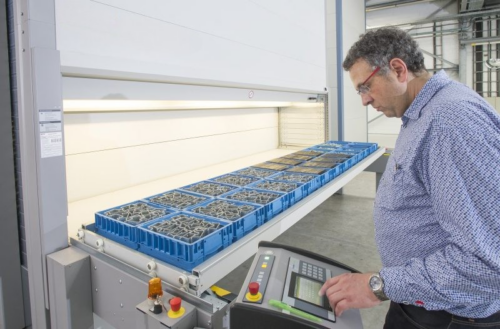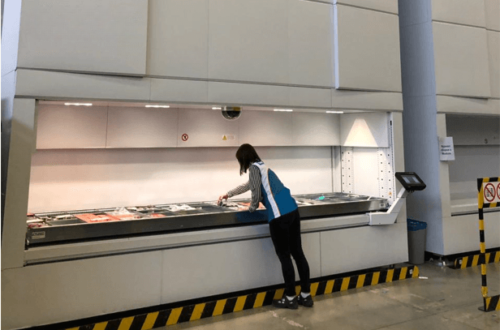Do More With Less: How High-Density Storage Is Reshaping Warehouse Efficiency

High-density storage systems like Vertical Lift Modules are helping operations reclaim space, boost accuracy, and reduce labor strain; all without expanding their footprint.
Warehouses across the country are running into the same challenge: they’re running out of space. But instead of building out, more operations are starting to look up. With rising industrial rents, labor shortages, and a growing mix of SKUs to manage, the pressure to maximize every inch of available space has never been greater. High-density storage systems, especially vertical lift modules (VLMs), are helping organizations turn underutilized overhead space into productive, streamlined inventory zones.
From e-commerce fulfillment centers to pharmaceutical distribution hubs, operations are adopting high-density storage to gain flexibility, reduce picking time, and defer costly facility expansions. These systems are proving that smarter storage can unlock more capacity, without touching the footprint.
Why Space Optimization Matters More Than Ever
For decades, the conventional response to warehouse growth was simple: add more shelving or expand the facility. But that approach is getting harder to justify. Industrial vacancy rates are shrinking in many regions, and costs for new construction are escalating. In high-demand markets, even finding a viable expansion site can take months.
At the same time, product lines are getting more complex. A growing SKU count means more inventory to manage, often in the same amount of space. Layer on rising labor costs, regulatory pressure, and consumer expectations for faster delivery, and it’s clear that the traditional warehouse model is reaching its limits.
This is why space optimization has become a strategic imperative. Warehouses are shifting from a horizontal to a vertical mindset. They’re asking, “How can we get more out of what we already have?”
That’s where high-density storage systems come in. By using automated technologies that leverage vertical space, facilities can dramatically increase storage capacity, reduce wasteful movement, and improve accuracy without expanding their footprint.
Companies like Vertical Storage USA are helping warehouses unlock this potential through customizable systems that integrate with existing workflows, whether in fulfillment centers, food processing plants, or aerospace parts storage.
Understanding Vertical Lift Modules

At the heart of many high-density storage strategies is the Vertical Lift Module. A VLM is a dynamic storage tower that automatically retrieves trays of inventory and delivers them to a centralized access point at waist height. Items are scanned into the system, and the machine stores each tray based on its height, optimizing space with each cycle.
Unlike traditional shelving, which requires wide aisles and extensive walking, VLMs are compact and bring the inventory to the worker. That makes them faster, safer, and significantly more space-efficient. In many applications, they reduce floor space usage by up to 90% compared to static shelving.
But the benefits go far beyond footprint. VLMs improve inventory visibility by integrating with warehouse management systems (WMS), allow for secure access control, and can be configured for temperature-sensitive or clean-room environments. From production lines to fulfillment centers, they adapt easily to existing operations.
If you’re considering customizable systems that integrate with existing workflows, VLMs offer a flexible, modular foundation for long-term efficiency.
The Role of Automation in Labor-Constrained Environments
One of the biggest challenges facing warehouse leaders today is labor. It’s not just about rising wages — many facilities are struggling to find qualified workers at all. Turnover rates remain high, and training new staff takes time and resources.
High-density storage systems help relieve that pressure by automating repetitive tasks and simplifying workflows. Instead of sending workers across a warehouse with a pick list, a VLM delivers the required items to a single ergonomic access point. The result: faster order fulfillment with fewer people.
This also leads to less fatigue and fewer injuries. VLMs eliminate the need for ladders, forklifts, or repeated bending and stretching. They reduce the physical strain of warehouse work, which not only improves employee satisfaction but also expands the talent pool by making roles more accessible.
In some industries, like medical device distribution or aerospace maintenance, the reduction in error rates is just as valuable as the labor savings. With pick-to-light guidance, barcode scanning, and inventory tracking built into the system, VLMs help ensure every item goes exactly where it needs to go, when it needs to get there.
Where VLMs and High-Density Storage Deliver the Most Value

Not every product or workflow is a good fit for high-density storage. But in the right environment, these systems can dramatically improve performance. Industries seeing the strongest ROI from VLM adoption include:
- Aerospace and defense: Manage thousands of critical spare parts with high accuracy and quick retrieval times.
- Manufacturing and assembly: Store components, tools, and fasteners near the point of use without cluttering the floor.
- Healthcare and pharma: Maintain strict access control, traceability, and cleanliness for medical inventory and supplies.
- Retail and e-commerce: Increase order picking speed and SKU density without expanding warehouse space.
- Food and beverage: Store packaging and specialty ingredients in clean, organized environments with optional temperature control.
These industries rely on efficient space utilization and fast, accurate inventory movement—two areas where high-density storage delivers significant value.
Implementation Considerations
Adding VLMs or other high-density systems to a warehouse isn’t just about installing new equipment, it’s about rethinking how inventory is handled and how workflows are designed. Before implementing a system, it’s important to evaluate:
- Ceiling height: VLMs often require 16 to 40 feet of vertical clearance.
- Floor load capacity: Because VLMs concentrate weight in a small footprint, floors may need reinforcement.
- Inventory profile: Not all SKUs belong in a VLM. Start with small, fast-moving, or high-value items.
- Software compatibility: WMS and ERP integration ensures the system works seamlessly with existing inventory systems.
- Change management: Clear communication and training help teams adapt quickly to new technology.
Companies like Vertical Storage USA provide design consultations, CAD layouts, and project management support to help operations get the most out of their investment.
Maximizing Performance with a Layered Storage Strategy
High-density storage doesn’t replace every racking system in a facility, but it can transform the most constrained areas. Many successful implementations use a layered approach: fast-moving parts go into VLMs, bulk goods remain on pallet racking, and seasonal or slow-turn items are stored offsite or in less accessible zones.
This hybrid strategy ensures that the highest-value inventory is stored in the most efficient format, while lower-priority goods still have a place. It also allows companies to adapt over time. As SKUs grow or shrink, storage zones can be reassigned, trays can be reconfigured, and additional towers can be added without starting over.
In this way, high-density storage becomes not just a space-saver, but a scalable infrastructure for long-term warehouse performance.
Calculating ROI and Long-Term Value
The payback period for a VLM or similar system depends on the operation, but many businesses recover their investment within 12 to 18 months. Key drivers of ROI include:
- Space savings (often delaying or avoiding expansion)
- Reduced labor hours for picking and replenishment
- Improved inventory accuracy and fewer mis-ships
- Increased throughput using the same or fewer employees
- Lower injury risk and insurance costs
To help visualize savings, Vertical Storage USA’s free ROI calculator allows companies to input their facility metrics and generate a tailored estimate. This tool has proven useful in building internal business cases, especially when justifying capital investments to finance teams.
Beyond hard numbers, companies also cite intangible benefits: cleaner warehouse layouts, improved employee morale, more consistent order performance, and easier onboarding for new staff.
Storage as a Strategic Asset

In a fast-moving supply chain environment, warehouse storage can’t be static. It must flex with product lines, scale with demand, and support rapid shifts in operations. That’s why high-density storage systems are gaining attention—not just as equipment, but as strategic assets.
By reclaiming vertical space, increasing automation, and improving access to inventory, these systems do more than solve today’s space problems. They create infrastructure that supports growth, agility, and continuous improvement.
For many companies, VLMs are a stepping stone toward larger automation initiatives. For others, they’re a standalone solution that unlocks new capacity and speed. In either case, they represent a shift in how warehouses think about space—not as a fixed limit, but as an opportunity to grow smarter.
Conclusion: Rethinking the Role of Storage
As warehouse and distribution leaders confront rising costs, labor constraints, and operational complexity, one thing has become clear: you can’t scale tomorrow’s supply chain with yesterday’s storage model.
High-density systems like vertical lift modules help reimagine what’s possible within the same four walls. They don’t just store more in less space; they reduce pick times, enhance worker safety, improve accuracy, and support long-term scalability.
Whether your operation is outgrowing its footprint or simply seeking a more efficient way to manage inventory, the answer might not be found in a new building. It might be sitting just above your head.
Interested in getting started? Contact Vertical Storage USA to schedule a layout consultation or explore available inventory today.
